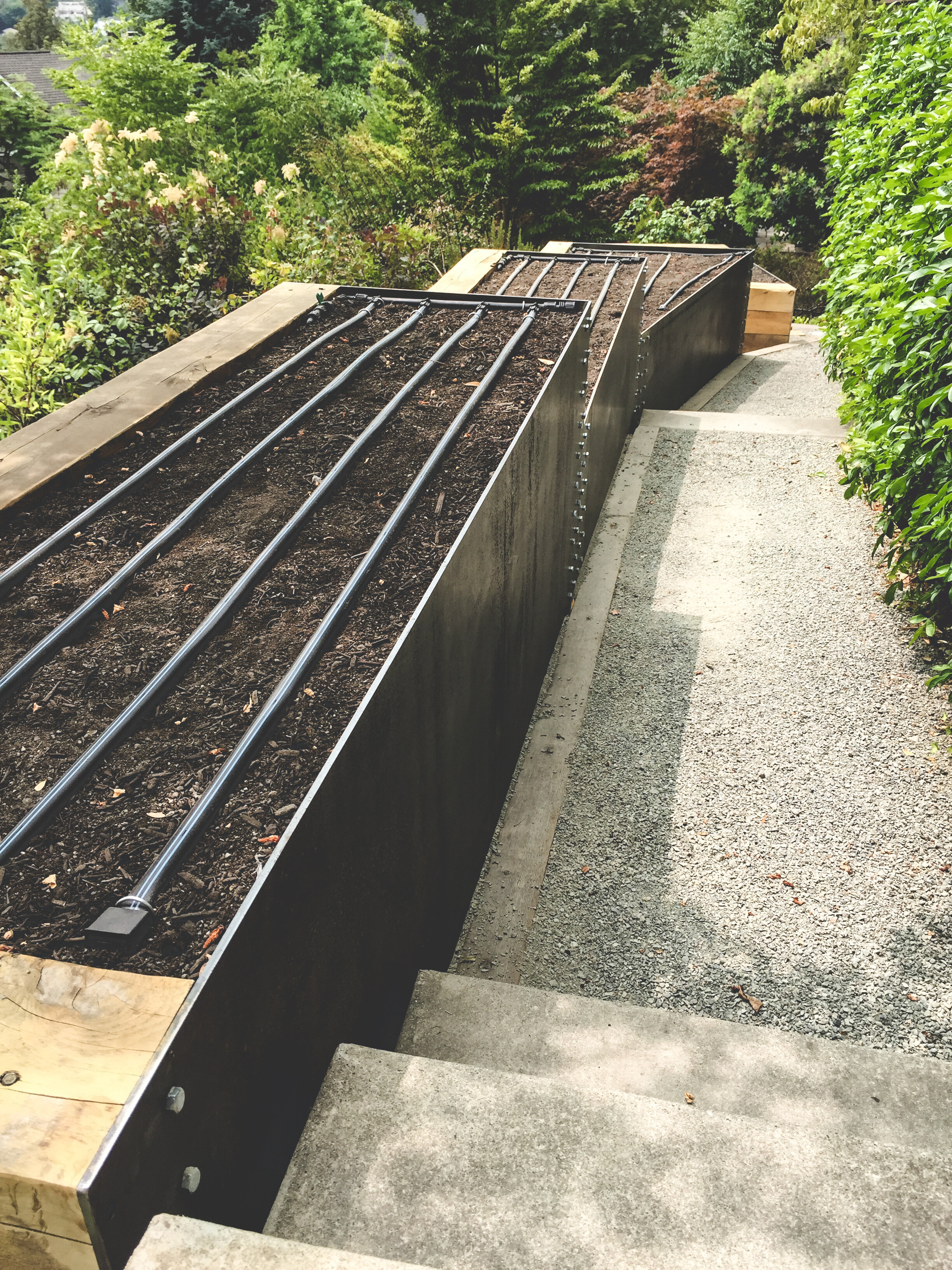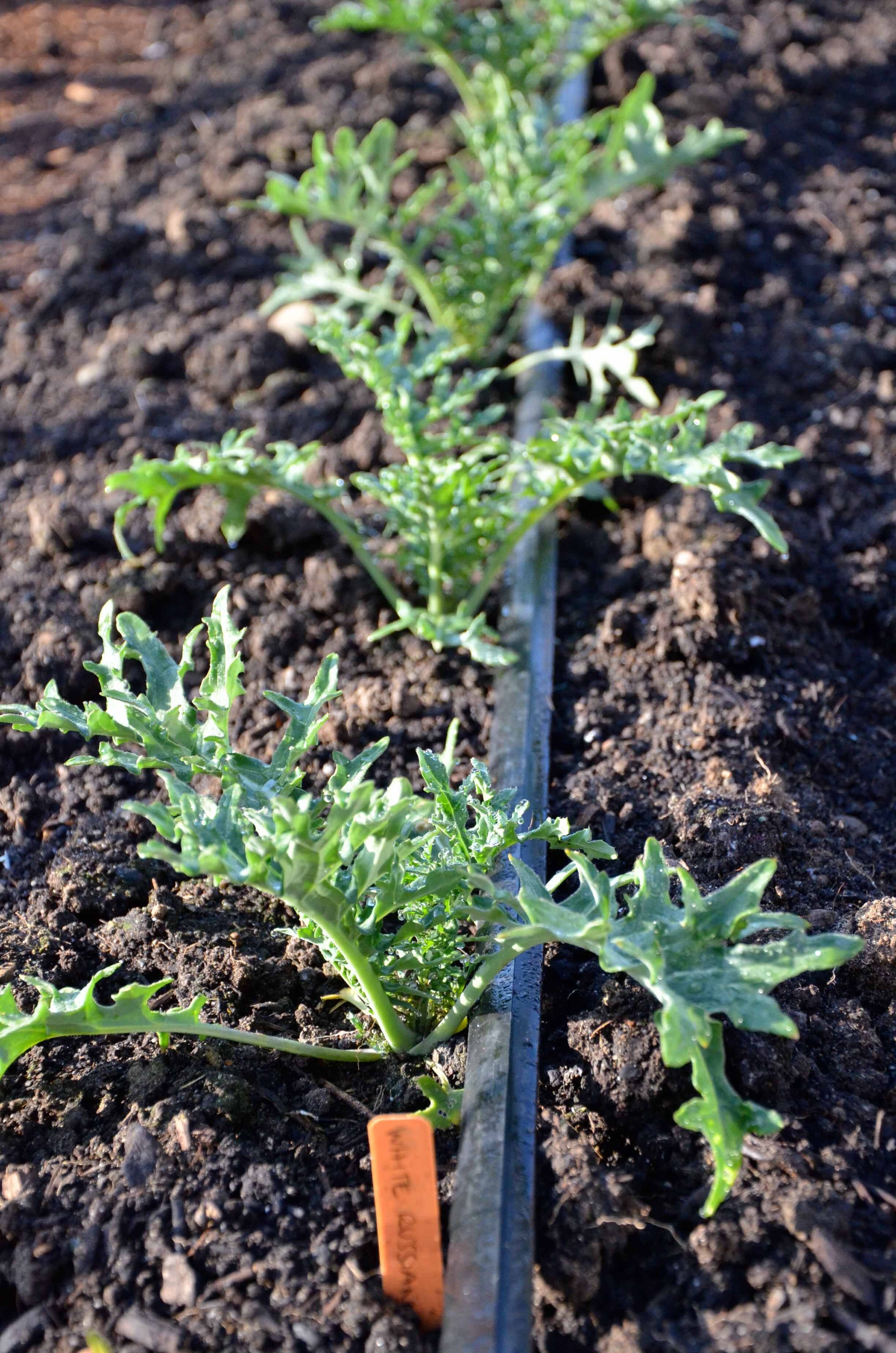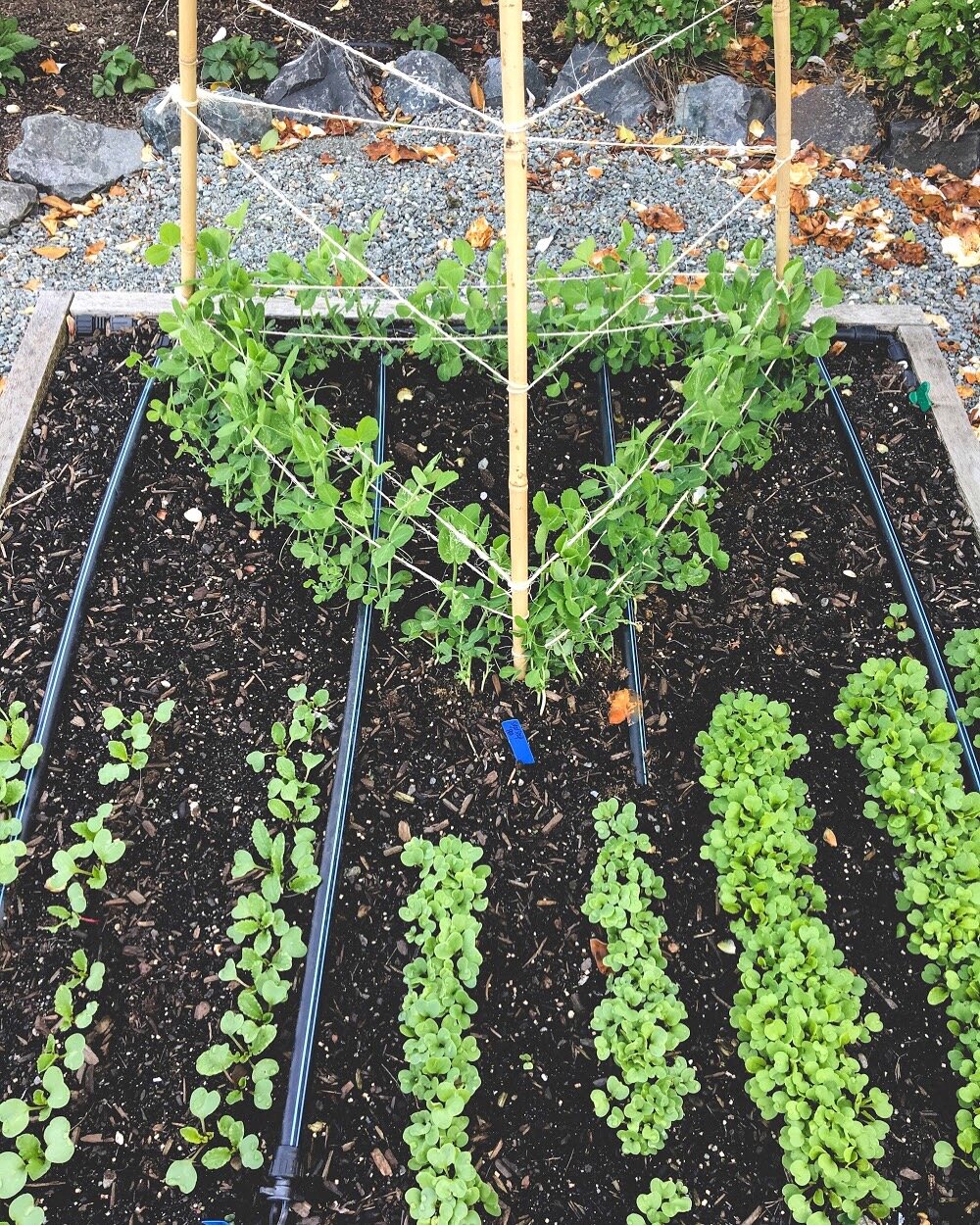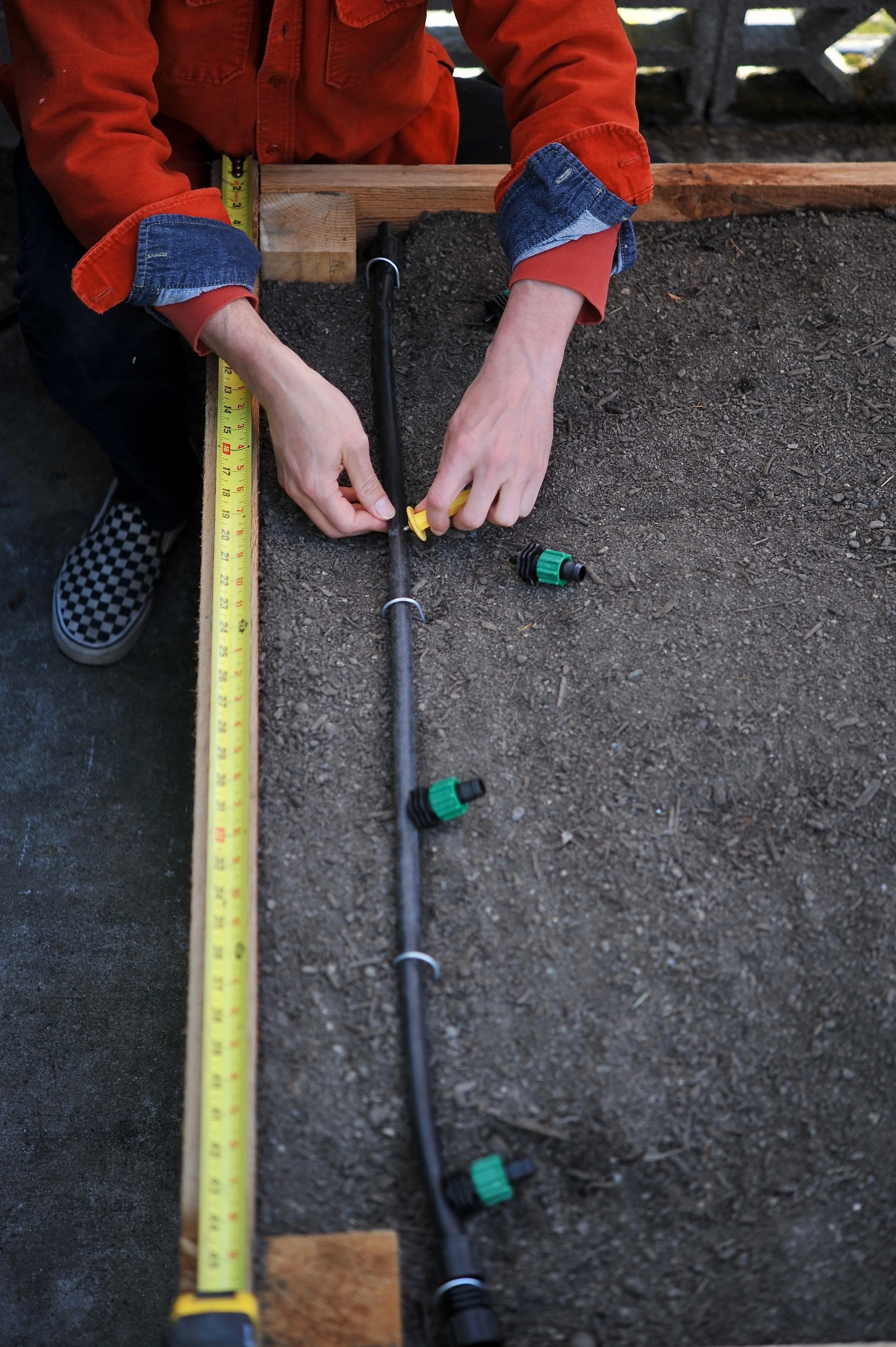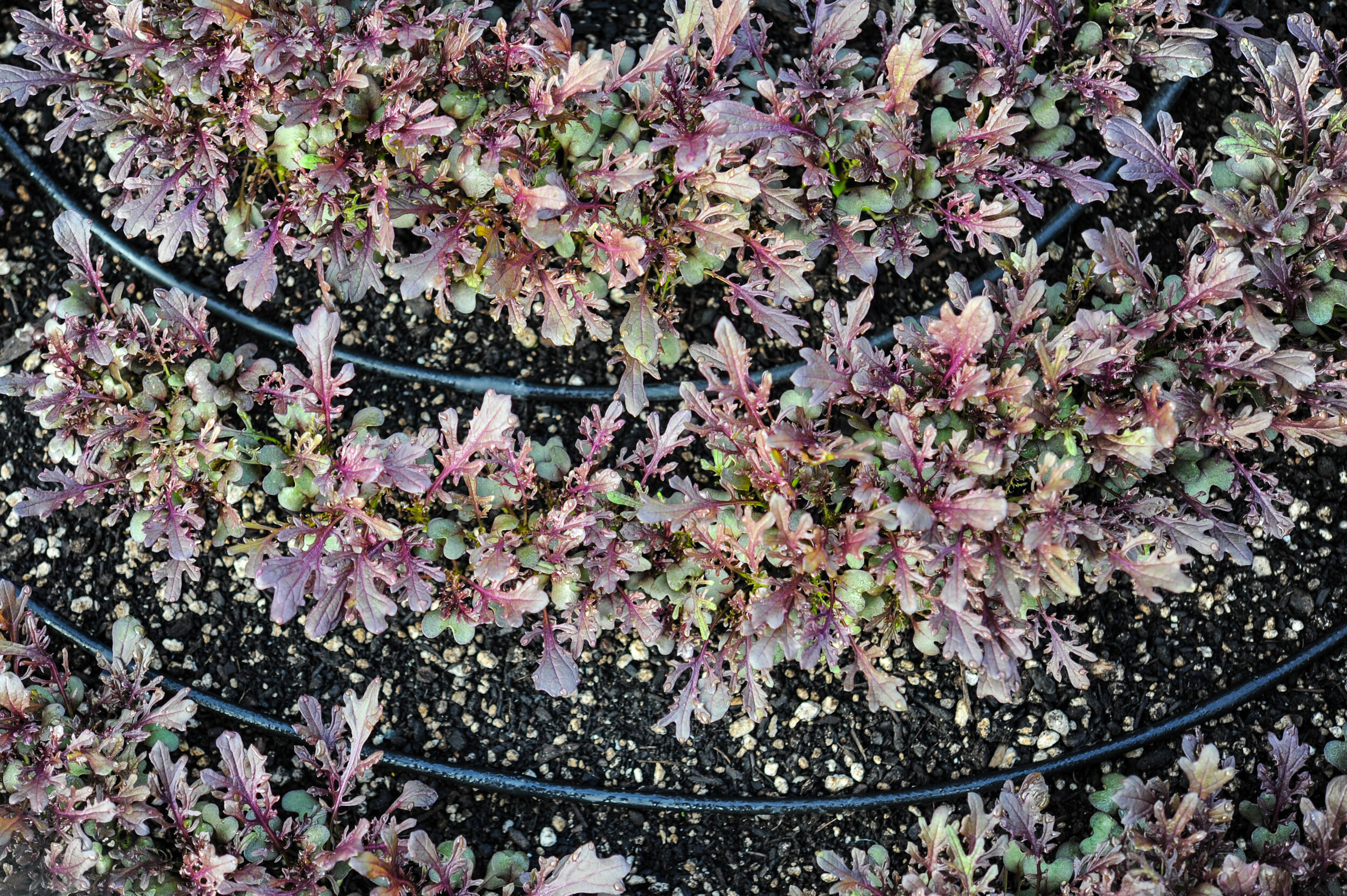All About Drip Irrigation
Installing a drip irrigation system on an automatic timer is one of the most effective ways to improve your garden’s productivity, while saving you time and money. Drip irrigation is a system of narrow plastic tubes that deliver water at a slow rate directly to the surface of the soil. Since the water is emitted slowly, it has time to soak into the soil, rather than run off or through the soil. A properly installed and monitored drip system will deliver just the right amount of water with very little waste.
Once installed, a drip system is largely hands-off, although you will want to check the moisture level of the soil every week or so as the weather changes. This will help make sure you are not over- or underwatering. A weekly moisture check and a 30-second update to your timer settings will ensure proper watering all season long.
Applying water directly to the soil surface is the most resource-efficient way to irrigate your plants. Drip irrigation allows you to water the portions of the garden planted in crops, reducing weed growth in bed edges and pathways.
Drip irrigation Q & A
We polled our followers on Instagram, and have answered their top drip irrigation questions below.
To keep the Q & A as simple as possible, I’m using the following guidelines:
This blog only addresses drip tape, which is best used in rectilinear spaces. I’ll address irrigation for container gardening and organic-shaped spaces in a later blog.
I’m using a 4’x8’ rectangular bed as my “control” here. Gardens come in all sizes and shapes, and I’m not saying that you should build 4x8 beds. They just provide an easy way to illustrate drip irrigation concepts.
Q: I'd be interested to know if there are ways to DIY this without a kit. Maybe more time/labor intensive, but cheaper?
A: It depends on the size of your garden. If you’re setting up a system for an area where the total bed space adds up to 192 square feet or less (or 6 4x8’ beds), I’d go with the one of the drip kits we recommend. Try the Dripworks Drip Tape Kit for rectilinear framed beds or in-ground beds, and the Garden Bed Irrigation kit for container gardens.
Of course, buying in bulk is always cheaper as long as you have the need for a lot of materials. For example, a 4000’ roll of Aqua-Traxx drip tape with 8” spaced emitters, costs around $228. This is enough tape to run irrigation to over one-hundred and twenty 4’x8’ raised beds! A small drip kit may come with 200’ of drip tape, or enough for around 192 square feet of garden space. This would allow you to irrigate six 4’x8’ foot raised beds and costs about $85.
Unless you’re planning to set up dozens of irrigation systems each year, or you’re creating a system for a very large garden, the 4000’ roll of tape will probably be a waste of money. This might be a better approach: For around $135 you can buy a drip tape kit that can service up to six 4’x8’* beds, extra tape locs, and the hose end timer we recommend. In other words, everything you need for your drip system.**
If you do want to piece together your own kit, our book, “Food Grown Right, In Your Backyard” lists out all of the different supplies you’ll need and you can find many of them here.
*How am I calculating the square footage covered by the small drip tape kit ? We recommend spacing drip lines about 12” apart, so in each 4’x8’ bed you’ll need 4 lines. When capping the end of your drip lines, you end up folding over a few inches of the line, so accounting for that and a few minor mistakes, I’m assuming at each bed will require four 8.33’ drip lines. (4 x 8.33)6=200.
**If you’re going to set up tapes in more than two 4’x8’ raised beds, you’ll need more tape locs (aka. Drip Tape Row Starts). We space our tapes about 12” apart, so each 4’x8’ bed needs 4 tape locs, and the kit only comes with ten. You can also buy more tape ends (to cap your irrigation) or you can use our old hack of cutting a 3-inch piece of drip tape (most of you should have extra!), folding your active tape ends over three times and sliding them into the cut piece.
Q: How much does it actually cost to install a drip system for four 4’x8’ beds?
A: I think the most efficient set up would cost around $135. See the last question :)
Q: Suggestions for installing amongst multiple raised beds without creating trip hazards? Is it as simple as burying lines between beds?
A: The main line, or header tubing, will be connected to your water source and you’ll run your drip tapes off of this line. This is the line you need to worry about becoming a trip hazard because it will likely run though parts of your site that are not necessarily designated garden space. In a perfect scenario you’ll be placing your beds near a water source and on top of sod, soil, gravel, or some other malleable surface that can easily be dug up so the lines can be buried a few inches underground.
If you can’t bury your main lines, you’ll have to get creative. Do your best to secure or bury any exposed lines running from your water source to your garden. In some cases, when lines can’t be buried, we’ll run our main line a little longer, and around a more circuitous route so that the lines can be secured to the edge of a house, deck or fence, instead of running across a patio or other impervious surface and creating an unsightly tripping hazard. These pipe straps come in handy when trying to secure your main line to your beds or surrounding surfaces.
Q: Do you bury [the drip tapes] or leave them on top of the soil?
A: We leave them on top of the soil during the growing season. We’ve found that they’re less likely to get clogged or damaged by our enthusiastic gardeners that way. Leaving them on top of the soil also helps to keep them top ½ inch or so of soil moist, which is crucial for seed germination.
In the winter, we top off all of our garden beds with 2-3 inches of compost. We leave the tapes under the compost during the winter.
Q: I want my drip system to be sustainable, it seems like everything at the local hardware store never lasts more than a season, so maybe products that are more sustainable.
A: A quality drip system should last many years. Off the top of my head I can think of at least a dozen gardens that we still maintain on a regular basis which have the original drip system we installed when we first built the garden over 10 years ago. Look for high quality, agricultural-grade materials, like the ones we recommend here.
Inevitably, any system is going to need repairs here and there, which is another reason why we recommend the products we do - they're much easier to work with than the other options out there.
Q: I’ve found with our hard water my system gets clogged easily, it may be the cheap stuff I bought?
A: Be sure to install a filter at your water source. These simple and inexpensive tee filters are what we use. The bottom screws off and the metal mesh filter can be easily taken out and cleaned or replaced without unscrewing your entire system.
Q: I would love to hear more about drip tape.
A: Drip lines bring water from your main line to your crops.
Drip tapes: If you have a square or rectangular garden, drip tapes are the way to go. They are low in cost, super-efficient at using water, and distribute it uniformly throughout your garden. Drip tapes are essentially long flat tubes with built in emitters that fill with water when under pressure.
When choosing a drip tape brand, look for a product that has emitters spaces every 6-9 inches and is pressure compensating, which means it distributes water equally throughout the whole system regardless of row length (within limits) and elevation changes. The downside of drip tape is that it can only be used in a straight line, so it’s not great for containers or curvy beds.
Q: I’m curious about how you address plants with different watering needs. My carrots germinate better if I have a sprinkler head spraying them, but other plants like to have water dripped right at the base of the plant.
A: This is a great question. In general, I’d say that a drip tape system should take care of all of your garden’s needs (I’m not addressing greenhouse or plant nursery needs here-which are different). It’s true that some crops such as carrots can benefit from additional overhead watering when it comes to ensuring consistent seed germination.
With that said, we don’t use overhead watering systems in any of the 80 or so gardens we maintain each year, and we have great success with germination. We’ve found that hand watering your newly planted seeds is crucial. Regardless of how effective our drip systems are, we never direct seed or transplant any crop without hand watering it in using a hose end sprayer set to “shower”. This first soaking goes a long way in assisting germination and reducing transplanting-related issues.
Also, as I mentioned earlier, we don’t bury our drip lines and ensuring high rates of germination is one of the reasons why. If your tapes are on top of the soil, the first ½ inch of soil is more likely to stay moist as seeds are germinating.
Another technique to be aware of when direct-seeding in a garden with a drip-system is seeding along the drip line. We space our drip tapes 12 inches apart because most annual vegetable plants require 6-12 inch spacing. Direct seeding within 1-2 inches of your drip line will also help to ensure consistent germination.
Q: I assume it's easiest to set up before the season starts.
A: The easiest time to install a drip irrigation system is while you are initially building the garden. The second best time is between garden seasons, either at the end of the fall season or early spring before planting begins again. Installing a system mid-season can be tricky because you will need to delicately work around all of your established structures and plants.
Q: What kinds of modifications, if any, does one need if they already have long season plants in beds, like garlic?
A: As long as your existing plants are spaced properly, installing drip lines around them shouldn’t be a problem.
Q: Should the lines be taken out over winter?
A: the drip irrigation systems we recommend are easy to winterize, because the lines don’t hold water when the system isn’t running. Thus, you may be able to leave main lines and drip lines in place over the winter without risk of damage. When setting up a system, it’s a good idea to create an end at the lowest part of the garden that can be opened up to let water drain out. Fittings for mainline tubing are easy to remove and function as this type of drain. If you live in an area with very cold winters, it may be a good idea to use an air compressor to blow water out of any buried lines before winter sets in.
Before the temperature drops below freezing, turn the water off at the hose bib and bring your timer inside for the winter. You may also want to disconnect any other fittings near the timer such as the filter and pressure regulator and store these in the garage. If you have a Y-valve, make sure both valves are open to let water drain out.
Q: If one has tall raised beds, should the line be buried underneath, or go over the top?
A: We always recommend running your main lines under your beds if possible. This isn’t always practical if you’re installing a system in an existing garden.
Q: How long should the lines last before they need to be replaced?
A: I can think of many gardens we installed 10-12 years ago that still have their original drip systems...so quite a long time! You will inevitably need to patch holes in the drip tape (use these couplers or just replace the entire length of tape), but the full system should last years.
Good luck setting up your drip system, I hope these tips help!
More Drip Irrigaiton Resources:
If you’re a podcast fan, or just want to dig deeper into the world of drip irrigaiton, the following resources from our archives have got you covered.


